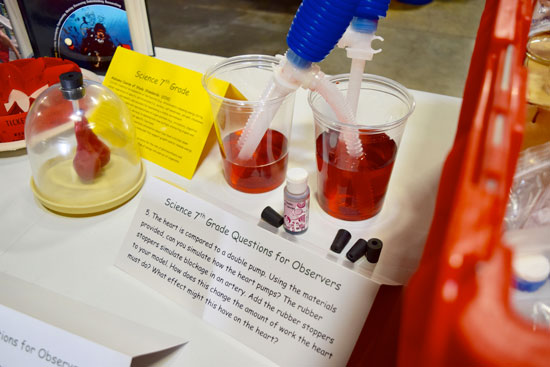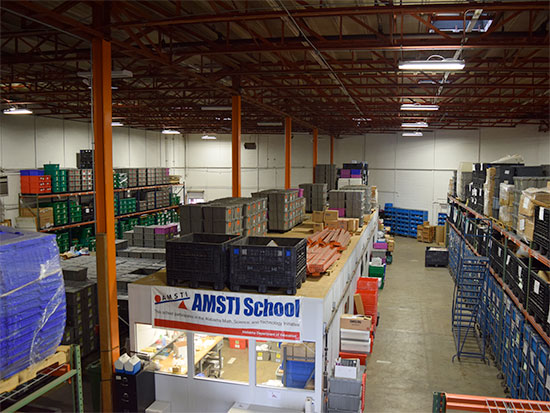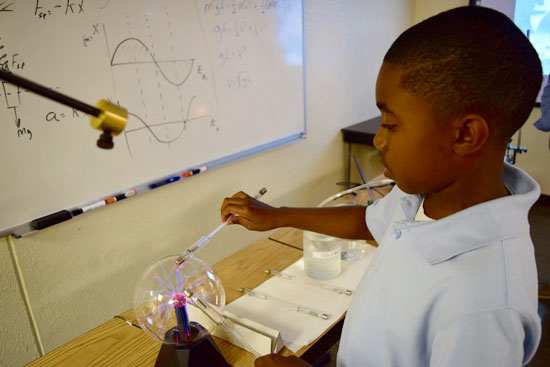Written by: Tiffany Westry
Need more info? Contact us
 Science kits like the one above are delivered to schools in Region 5 every 9 weeks.Each time a white box truck with a picture of the state of Alabama, a fulcrum balance scale and AMSTI painted across the side travels along an Alabama highway, math and science equipment is on its way to an area classroom.
Science kits like the one above are delivered to schools in Region 5 every 9 weeks.Each time a white box truck with a picture of the state of Alabama, a fulcrum balance scale and AMSTI painted across the side travels along an Alabama highway, math and science equipment is on its way to an area classroom.
The University of Alabama at Birmingham is one of 11 Alabama Math, Science, and Technology Initiative sites across the state. AMSTI was created by the Alabama State Department of Education in 2000 to improve math and science teaching. The goal is to provide all students in grades K-12 with the knowledge and skills needed for success in the workforce and/or postsecondary studies through a “learning by doing” approach.
AMSTI has received both national and international attention for its effectiveness in raising achievement scores and improving student interest in math and science. As the largest and most comprehensive math and science initiative in the nation, AMSTI has become the leading model for math and science education reform.
 Science and math equipment for Region 5 is housed in a 14,000 square-foot warehouse managed by AMSTI-UAB staff.AMSTI-UAB provides grade-level-specific training, materials and continued support throughout the school year to teachers in the school systems that make up AMSTI Region 5: Bessemer City, Birmingham City, Fairfield City, Jefferson County, Leeds City, Midfield City, Tarrant City and Trussville City.
Science and math equipment for Region 5 is housed in a 14,000 square-foot warehouse managed by AMSTI-UAB staff.AMSTI-UAB provides grade-level-specific training, materials and continued support throughout the school year to teachers in the school systems that make up AMSTI Region 5: Bessemer City, Birmingham City, Fairfield City, Jefferson County, Leeds City, Midfield City, Tarrant City and Trussville City.
“The benefit of AMSTI for teachers is tremendous,” said Becke Stripling, director of AMSTI-UAB. “AMSTI bridges the gap between the theory of best practices and what that looks like for teachers in their classrooms. The teachers become learners as we walk them through each lesson and discuss which best practices can be applied based on what the lesson contains.”
AMSTI science lessons cover the course of study completely, and the practice of conceptual understanding of numbers is emphasized in all math lessons. Materials kits are delivered every nine weeks from a 14,400-square-foot warehouse managed by AMSTI-UAB staff. The equipment ranges from plastic cups and cotton balls to cutting-edge technology like mass spectrophotometers, DNA replicators, gel electrophoresis equipment, graphing calculators, GPS devices and nuclear scalars. The equipment supports more than 750 teachers and 20,000 students in its region.
 Fourth grader Caleb Lykes plays with plasma globe.Schools must apply to join AMSTI. Once accepted, math and science teachers and administrators attend two week summer institutes for two consecutive years. Each AMSTI teacher receives 120 hours of subject- and grade-specific professional development during the institutes. UAB held its first summer institute in 2007, training approximately 300 teachers.
Fourth grader Caleb Lykes plays with plasma globe.Schools must apply to join AMSTI. Once accepted, math and science teachers and administrators attend two week summer institutes for two consecutive years. Each AMSTI teacher receives 120 hours of subject- and grade-specific professional development during the institutes. UAB held its first summer institute in 2007, training approximately 300 teachers.
At the institutes, teachers conduct all of the hands-on activities they will eventually perform with their students. Upon returning to their schools, they receive all of the equipment and materials needed to engage their students in hands-on, activity-based instruction. After the institutes, full-time AMSTI math and science specialists mentor the teachers in their classrooms until they become comfortable with the AMSTI approach to teaching.
“The level of mentoring is according to the needs of the teacher,” said Cindy Willingham, assistant director. “We will help them as long as they ask us to. We also do continuous mentorship within professional learning communities for all teachers in our region, so opportunities for professional development continue long after the summer institutes.”
UAB is also an Alabama Science in Motion site. ASIM is the high school component of the Alabama Math, Science, and Technology Initiative. AMSTI-UAB and ASIM-UAB joined forces in 2012 to expand their reach and provide high-tech laboratory experiences for high school science students and effective professional development for teachers. ASIM began at UAB in 1994 with a focus on high school chemistry and physics. A biology specialty was added in 2007.